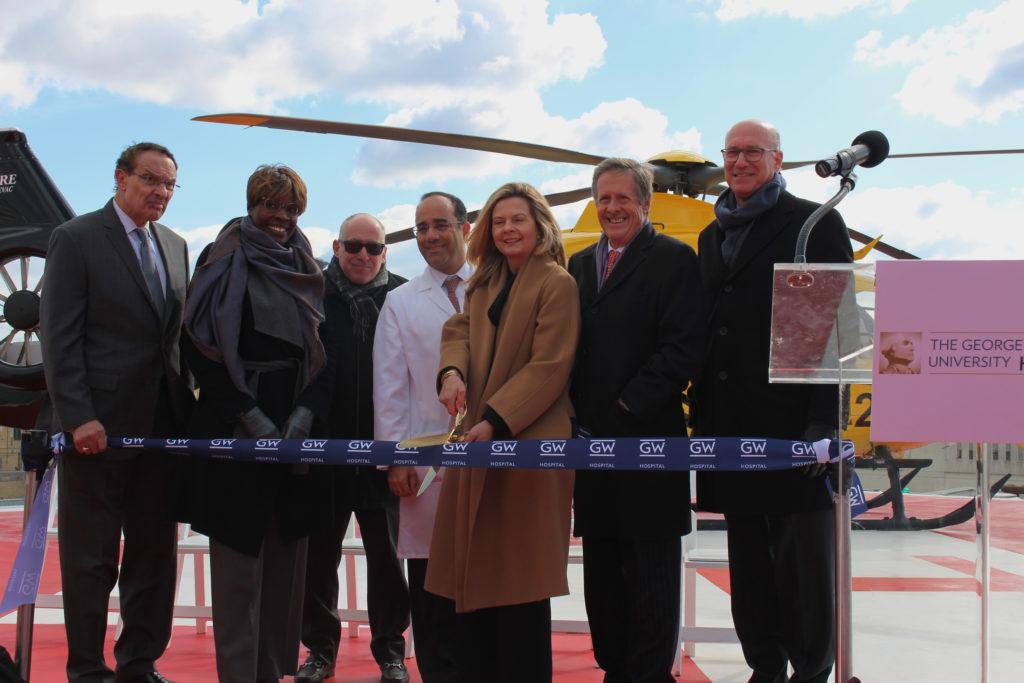GW Hospital officials and community members gathered for a ribbon-cutting ceremony Friday morning to open the first helipad constructed atop the hospital.
After years of community debate over whether helicopters landing on the hospital would be too noisy, the D.C. Council approved helipad construction in June 2018, under the condition that Mayor Muriel Bowser can evaluate the helipad and issue further restrictions after 175 helicopter flights. Foggy Bottom and West End Advisory Neighborhood Commissioners and GW Hospital doctors said the helipad will allow patients to be easily transported to the hospital in emergencies.
GW Hospital CEO Kimberly Russo said the helipad will help the hospital, a designated Trauma One center, offer essential care for some of the most severely injured patients in D.C.
“This helipad will allow us to provide our patients with access to this critical level of care which will help prevent unnecessary deaths in our region,” Russo said.
Commissioner Patrick Kennedy, who helped facilitate negotiations between community members and GW Hospital officials as ANC chairman in 2016, said commissioners worked to balance Foggy Bottom residents’ concerns about added noise from helicopter trips with the needs of the larger D.C. community.
Residents initially pushed back against the helipad, arguing that the noise from the helicopter would disrupt neighborhoods surrounding the hospital. A study GW Hospital conducted in 2017 concluded that the added noise from the helipad would likely be no louder than ambulance sirens.
Student leaders submitted written testimony to the D.C. Council in April 2018 urging councilmembers to approve helipad construction. Leaders said the occasional helicopter noise students might hear would not outweigh the life-saving benefits airlifting patients to the hospital can offer.
“The process was very long and, at times, very heated,” Kennedy said.
Babak Sarani, the hospital’s head trauma surgeon, said the helicopter will only be utilized if a patient’s life is on the line. Sarani proposed the idea of a helipad atop the GW Hospital in 2012.
“We worked with our Foggy Bottom neighbors to build the helipad with the promise that we would only use it when a fellow human being’s life was truly in jeopardy,” he said.
Robert Kelly, the Medical Faculty Associates CEO, said the helipad is a “breakthrough” for the hospital because an extra few minutes of transportation time can determine whether a patient lives or dies.
“Every second counts,” Kelly said. “And the teams that have come together here, the caregivers, the nurses, the technicians and first responders bringing the patients in, this is a huge breakthrough.”
Jonathan Ryner, the director of cardiac catheterization laboratories, said he noticed the hospital’s need for a helipad while working at the hospital during the attacks on the World Trade Center towers on 9/11. Ryner said helicopters carrying patients had to land in spots like polo fields or the National Mall instead of on top of the GW Hospital.
“I once had a family of a heart attack patient being flown from the Eastern shore of Maryland arrive by car faster than the patient came by helicopter,” Ryner said. “GW needed a helipad.”
Megan Quintana, a trauma surgeon at the hospital, said the helicopter will transfer critically ill patients to the hospital faster than ambulances that have to weave through D.C.’s “challenging” traffic.
“Having air trafficking capabilities is going to be very beneficial, and I think it will just help the patients that need to be taken care of quickly here faster and more efficiently,” Quintana said.





